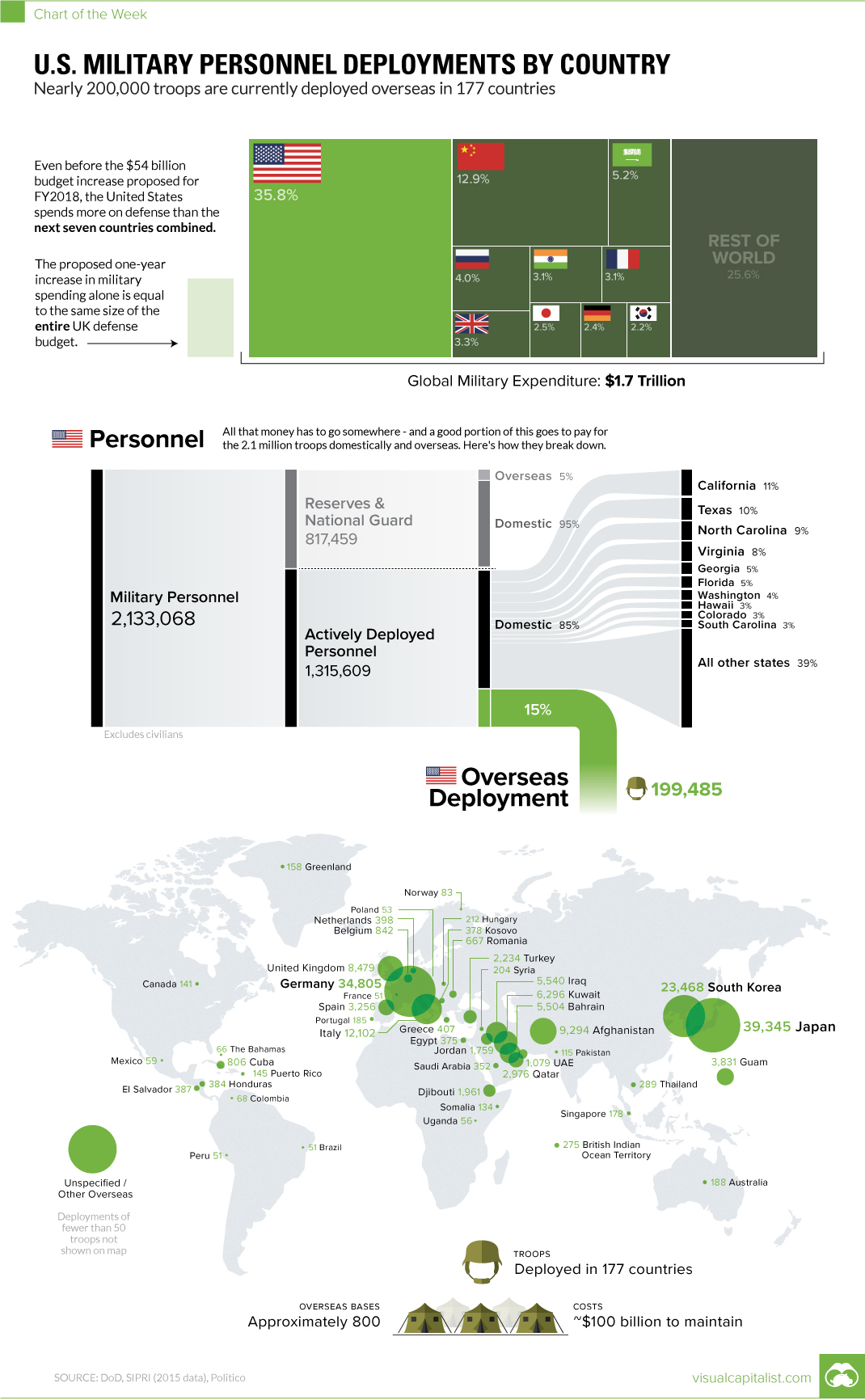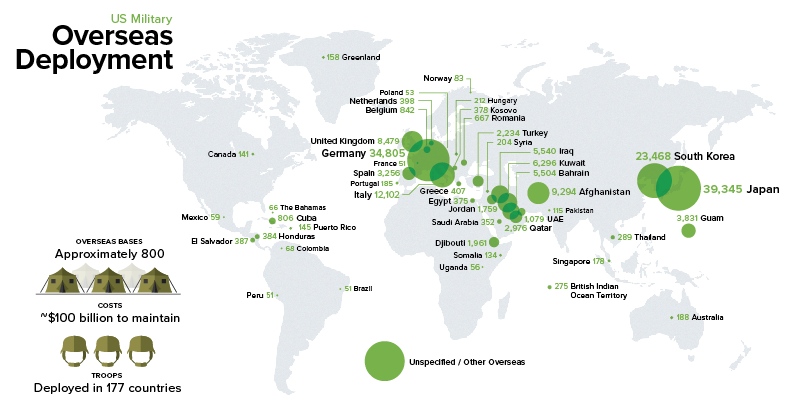Politics
U.S. Military Personnel Deployments by Country

U.S. Military Personnel Deployments by Country
200k active troops overseas in 177 countries
The Chart of the Week is a weekly Visual Capitalist feature on Fridays.
There was no shortage of cuts proposed in Trump’s budget for 2018, which was released earlier this week.
However, one of the few departments that did not receive a haircut was the Department of Defense. If the proposed budget ultimately passes in Congress, the DoD would be allocated an extra $54 billion in federal funding – a 10% increase that would be one of the largest one-year defense budget increases in American History.
To put the proposed increase in context, the United States already spends more on defense than the next seven countries combined. Meanwhile, the additional $54 billion is about the size of the United Kingdom’s entire defense budget.
| Country | Military Spending (2015) | Share |
|---|---|---|
| United States | $596 billion | 35.8% |
| China | $215 billion | 12.9% |
| Saudi Arabia | $87 billion | 5.2% |
| Russia | $66 billion | 4.0% |
| United Kingdom | $55 billion | 3.3% |
| India | $51 billion | 3.1% |
| France | $51 billion | 3.1% |
| Japan | $41 billion | 2.5% |
| Germany | $39 billion | 2.4% |
| South Korea | $36 billion | 2.2% |
| Others | $427 billion | 25.6% |
“Be All You Can Be”
With over half of all U.S. discretionary spending being put towards the military each year, the U.S. is able to have extensive operations both at home and abroad. Our chart for this week breaks down military personnel based on the latest numbers released by the DoD on February 27, 2017.
In total, excluding civilian support staff, there are about 2.1 million troops. Of those, 1.3 million are on active duty, while about 800,000 are in reserve or part of the National Guard.
On a domestic basis, there are about 1.1 million active troops stationed in the United States, and here’s how they are grouped based on branch of service:
| Military Branch | Active Domestic Personnel | As a Percentage |
|---|---|---|
| Army | 394,236 | 35% |
| Navy | 283,499 | 25% |
| Marine Corps | 149,992 | 13% |
| Air Force | 249,738 | 22% |
| Coast Guard | 38,659 | 3% |
| Total | 1,116,124 | 100% |
Internationally, there are just under 200,000 troops that are stationed in 177 countries throughout the world.
Here are the top 20 countries they are stationed in, as well as an “Other” category that represents the rest:
| Rank | Country / Territory | U.S. Troops |
|---|---|---|
| #1 | Japan | 39,345 |
| #2 | Germany | 34,805 |
| #3 | South Korea | 23,468 |
| #4 | Italy | 12,102 |
| #5 | Afghanistan | 9,294 |
| #6 | United Kingdom | 8,479 |
| #7 | Kuwait | 6,296 |
| #8 | Iraq | 5,540 |
| #9 | Bahrain | 5,504 |
| #10 | Guam | 3,831 |
| #11 | Spain | 3,256 |
| #12 | Qatar | 2,976 |
| #13 | Turkey | 2,234 |
| #14 | Djibouti | 1,961 |
| #15 | Jordan | 1,759 |
| #16 | United Arab Emirates | 1,079 |
| #17 | Belgium | 842 |
| #18 | Cuba | 806 |
| #19 | Romania | 667 |
| #20 | Greece | 407 |
| Other / Unknown | 34,834 | |
| Total | 199,485 |
In 2015, Politico estimated that there are 800 U.S. bases abroad, and that it costs up to $100 billion annually to maintain this international presence.
Economy
The Bloc Effect: International Trade with Geopolitical Allies on the Rise
Rising geopolitical tensions are shaping the future of international trade, but what is the effect on trading among G7 and BRICS countries?

The Bloc Effect: International Trade with Allies on the Rise
International trade has become increasingly fragmented over the last five years as countries have shifted to trading more with their geopolitical allies.
This graphic from The Hinrich Foundation, the first in a three-part series covering the future of trade, provides visual context to the growing divide in trade in G7 and pre-expansion BRICS countries, which are used as proxies for geopolitical blocs.
Trade Shifts in G7 and BRICS Countries
This analysis uses IMF data to examine differences in shares of exports within and between trading blocs from 2018 to 2023. For example, we looked at the percentage of China’s exports with other BRICS members as well as with G7 members to see how these proportions shifted in percentage points (pp) over time.
Countries traded nearly $270 billion more with allies in 2023 compared to 2018. This shift came at the expense of trade with rival blocs, which saw a decline of $314 billion.
Country Change in Exports Within Bloc (pp) Change in Exports With Other Bloc (pp)
🇮🇳 India 0.0 3.9
🇷🇺 Russia 0.7 -3.8
🇮🇹 Italy 0.8 -0.7
🇨🇦 Canada 0.9 -0.7
🇫🇷 France 1.0 -1.1
🇪🇺 EU 1.1 -1.5
🇩🇪 Germany 1.4 -2.1
🇿🇦 South Africa 1.5 1.5
🇺🇸 U.S. 1.6 -0.4
🇯🇵 Japan 2.0 -1.7
🇨🇳 China 2.1 -5.2
🇧🇷 Brazil 3.7 -3.3
🇬🇧 UK 10.2 0.5
All shifts reported are in percentage points. For example, the EU saw its share of exports to G7 countries rise from 74.3% in 2018 to 75.4% in 2023, which equates to a 1.1 percentage point increase.
The UK saw the largest uptick in trading with other countries within the G7 (+10.2 percentage points), namely the EU, as the post-Brexit trade slump to the region recovered.
Meanwhile, the U.S.-China trade dispute caused China’s share of exports to the G7 to fall by 5.2 percentage points from 2018 to 2023, the largest decline in our sample set. In fact, partly as a result of the conflict, the U.S. has by far the highest number of harmful tariffs in place.
The Russia-Ukraine War and ensuing sanctions by the West contributed to Russia’s share of exports to the G7 falling by 3.8 percentage points over the same timeframe.
India, South Africa, and the UK bucked the trend and continued to witness advances in exports with the opposing bloc.
Average Trade Shifts of G7 and BRICS Blocs
Though results varied significantly on a country-by-country basis, the broader trend towards favoring geopolitical allies in international trade is clear.
Bloc Change in Exports Within Bloc (pp) Change in Exports With Other Bloc (pp)
Average 2.1 -1.1
BRICS 1.6 -1.4
G7 incl. EU 2.4 -1.0
Overall, BRICS countries saw a larger shift away from exports with the other bloc, while for G7 countries the shift within their own bloc was more pronounced. This implies that though BRICS countries are trading less with the G7, they are relying more on trade partners outside their bloc to make up for the lost G7 share.
A Global Shift in International Trade and Geopolitical Proximity
The movement towards strengthening trade relations based on geopolitical proximity is a global trend.
The United Nations categorizes countries along a scale of geopolitical proximity based on UN voting records.
According to the organization’s analysis, international trade between geopolitically close countries rose from the first quarter of 2022 (when Russia first invaded Ukraine) to the third quarter of 2023 by over 6%. Conversely, trade with geopolitically distant countries declined.
The second piece in this series will explore China’s gradual move away from using the U.S. dollar in trade settlements.

Visit the Hinrich Foundation to learn more about the future of geopolitical trade

-

 Economy4 hours ago
Economy4 hours agoEconomic Growth Forecasts for G7 and BRICS Countries in 2024
The IMF has released its economic growth forecasts for 2024. How do the G7 and BRICS countries compare?
-

 United States1 week ago
United States1 week agoRanked: The Largest U.S. Corporations by Number of Employees
We visualized the top U.S. companies by employees, revealing the massive scale of retailers like Walmart, Target, and Home Depot.
-

 Economy2 weeks ago
Economy2 weeks agoWhere U.S. Inflation Hit the Hardest in March 2024
We visualized product categories that saw the highest % increase in price due to U.S. inflation as of March 2024.
-

 Economy4 weeks ago
Economy4 weeks agoG20 Inflation Rates: Feb 2024 vs COVID Peak
We visualize inflation rates across G20 countries as of Feb 2024, in the context of their COVID-19 pandemic peak.
-

 Economy1 month ago
Economy1 month agoMapped: Unemployment Claims by State
This visual heatmap of unemployment claims by state highlights New York, California, and Alaska leading the country by a wide margin.
-

 Economy2 months ago
Economy2 months agoConfidence in the Global Economy, by Country
Will the global economy be stronger in 2024 than in 2023?
-

 Markets1 week ago
Markets1 week agoU.S. Debt Interest Payments Reach $1 Trillion
-

 Business2 weeks ago
Business2 weeks agoCharted: Big Four Market Share by S&P 500 Audits
-

 Markets2 weeks ago
Markets2 weeks agoRanked: The Most Valuable Housing Markets in America
-

 Money2 weeks ago
Money2 weeks agoWhich States Have the Highest Minimum Wage in America?
-

 AI2 weeks ago
AI2 weeks agoRanked: Semiconductor Companies by Industry Revenue Share
-

 Markets2 weeks ago
Markets2 weeks agoRanked: The World’s Top Flight Routes, by Revenue
-

 Demographics2 weeks ago
Demographics2 weeks agoPopulation Projections: The World’s 6 Largest Countries in 2075
-

 Markets2 weeks ago
Markets2 weeks agoThe Top 10 States by Real GDP Growth in 2023
















